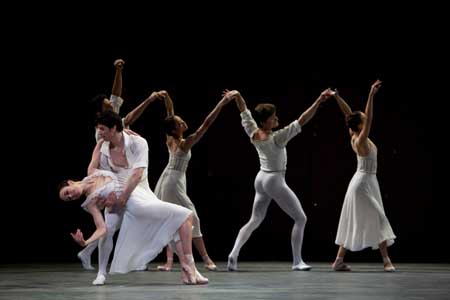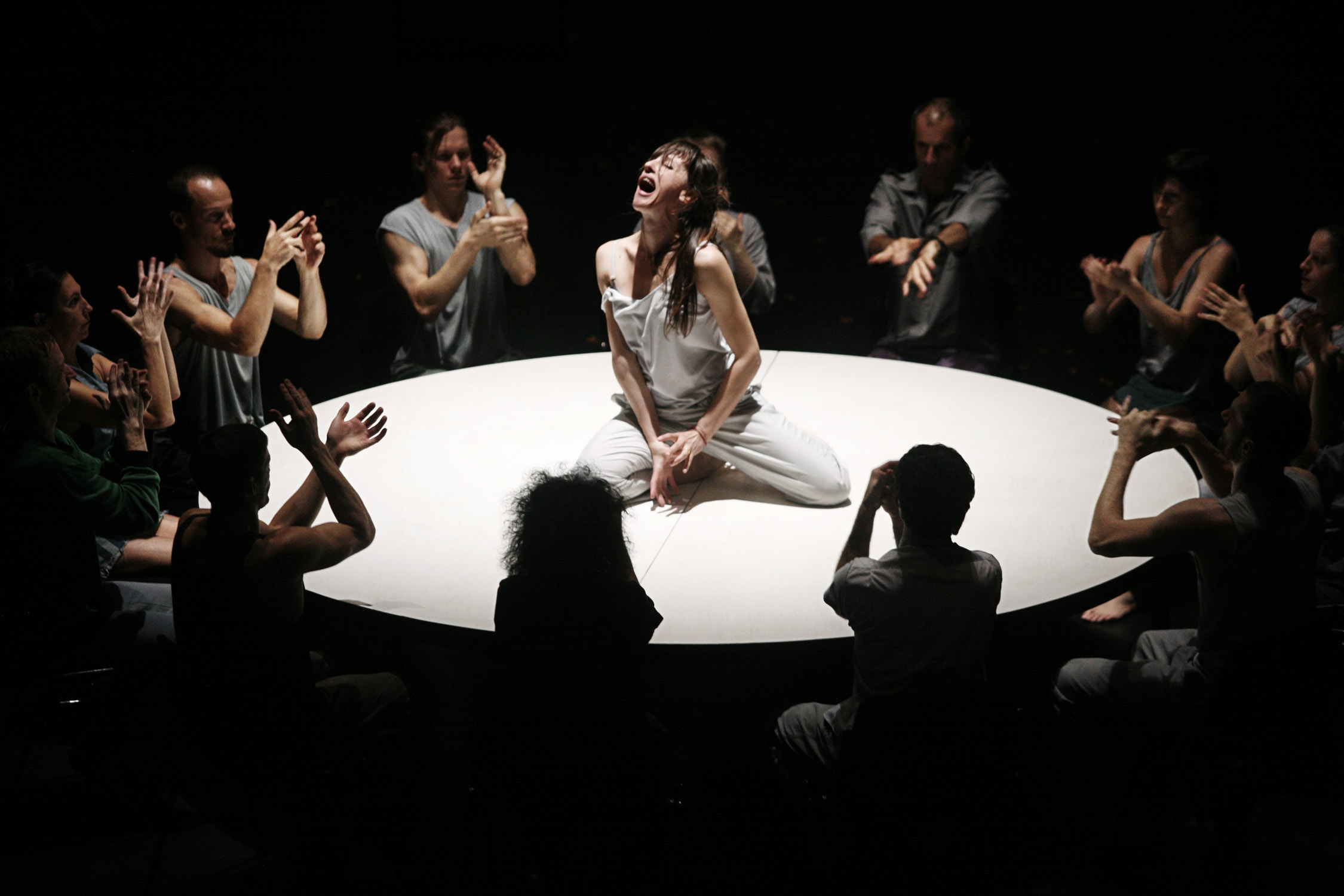Seeing Things: October 2009 Archives
American Ballet Theatre / Avery Fisher Hall, Lincoln Center, New York City / October 7-10, 2009
Avery Fisher Hall, Lincoln Center's main concert venue, lacks an orchestra pit, wing space, and a floor suitable for dancing. Musicians performing there stay put once onstage, limiting their motion to decorous walks to and from their places. Not for them phenomenal steps requiring a floor that cushions sleights of foot or a safe landing spot for leaping exits at race-car speed. Nevertheless American Ballet Theatre was installed at Avery Fisher for a four-day engagement, October 7-10.

Xiomara Reyes, Herman Cornejo, and friends in Alexei Ratmansky's Seven Sonatas
Photo: Rosalie O'Connor
The full article appeared in Voice of Dance (http://www.voiceofdance.org) on October 14, 2009. To read it, click here.
The Forsythe Company / BAM Howard Gilman Opera House / Brooklyn, NY / October 7-10, 2009
William Forsythe made his name creating ballets with an eye to pushing the art conspicuously forward, as Balanchine had done. Nowadays he makes concoctions that are so hard to appreciate, detractors find them empty, showy, foolish, inexplicable, or all of the above. It's not that I think he should retrace his early steps. Artists must not - cannot, actually--imitate their past. They need to move ahead to find their own future. I just wish I understood and liked Forsythe's recent work better.

Members of the Forsythe Company in Forsythe's Decreation
Photo: Julieta Cervantes
Decreation, which Forsythe and his devoted troupe brought to BAM'S Howard Gilman Opera House for an October 7-10 run, is not so much a dance as a dance cum postmodern drama cum installation cum performance art cum . . . well, you get the idea.
Forsythe's idea is that the world is in pretty hopeless shape. While its inhabitants obsess about communication, connection, empathy, and even love, he tells us, their actions invariably disintegrate into the cruel and bizarre. Though he keeps his stage tidier than the colossal-mess-loving Pina Bausch--even the dancers' clothes, shmatas you could clean the garage in, are fastidiously keyed to a subtle sky-and-earth palette--Decreation recalls the themes of her angst-driven earlier works.
The piece opens with a narrator standing behind a translucent box (also used as a projection screen, part of the media mix the choreographer favors), playing the dual role of defense attorney and accused. Her lines, delivered in a voice cracked with rage, alternate so swiftly between the two characters, they're barely intelligible.
The effect is like that of a particularly hostile Punch and Judy show.
In general, the sound is unbearably raucous, with overlapping verbal provocations accompanied by intermittent music played onstage and crackling static. The static may be there to remind us that everything we say nowadays is being recorded as info in the public domain, to be received by unsympathetic listeners. Occasional silences fail to bring relief; they only make one woman's low moaning audible.
As for the movement in the piece, it's usually violent and grotesque (angular, spasmodic, writhing)--and endlessly repetitive. The groupings, though, are so handsomely arranged, it's hard to believe that the anatomical incoherence represents authentic feeling.
Images suggesting sexual abuse abound. One pathetic figure often reappears, clutching one of her breasts with her right hand and her crotch with her left. She is the Eternal Female Victim, until she slips out of a contorted confrontation with two men, leaving them to undo each other.
Ten minutes into the one-hour show, you feel as if you've stumbled into a loony bin, albeit one that boasts high-end design and a façade of braininess. The latter comes across in exchanges like this one: He says, "Everything is beautiful and nothing hurt." But she says (he reports), "Everything hurt, everything that was beautiful." And then there's the persistent variation on this theme: "I might prefer to love another more than I love you. What would you do?" Only the libretto of one of the gayer Mozart operas could make such business viable, and then it would bubble with fun. Here it's rendered with pensive solemnity, reiterated so often you wonder why the guy at the receiving end doesn't counter with "Gimme a break already!"

The Forsythe Company in Forsythe's Decreation
Photo: Julieta Cervantes
In the final segment, the huge round table that loomed in the background is stripped of its formal dinner paraphernalia (crystal, china, sumptuous white cloth) and dragged forward, folding chairs placed to rim its periphery. The whole overwrought cast congregates, seated, for one last blast. Of course a distraught woman mounts the table (remember the Béjart Boléro?) and--oh, never mind. We've all been there before.
© 2009 Tobi Tobias
Sitelines
AJ Ads
 360° Dance Company at DTW offers two socially relevant revivals, Jane Dudley’s solo “Time Is Money” (1932) and Mary Anthony’s “Devil in Massachusetts” (1952) as well as the World Premier of Artistic Director, Martin Lofsnes' "6-1".
360° Dance Company at DTW offers two socially relevant revivals, Jane Dudley’s solo “Time Is Money” (1932) and Mary Anthony’s “Devil in Massachusetts” (1952) as well as the World Premier of Artistic Director, Martin Lofsnes' "6-1".
AJ Blogs
AJBlogCentral | rssculture
Terry Teachout on the arts in New York City
Andrew Taylor on the business of arts & culture
rock culture approximately
Laura Collins-Hughes on arts, culture and coverage
Richard Kessler on arts education
Douglas McLennan's blog
Dalouge Smith advocates for the Arts
Art from the American Outback
Chloe Veltman on how culture will save the world
For immediate release: the arts are marketable
No genre is the new genre
David Jays on theatre and dance
Paul Levy measures the Angles
Judith H. Dobrzynski on Culture
John Rockwell on the arts
innovations and impediments in not-for-profit arts
Jan Herman - arts, media & culture with 'tude
dance
Apollinaire Scherr talks about dance
Tobi Tobias on dance et al...
jazz
Howard Mandel's freelance Urban Improvisation
Focus on New Orleans. Jazz and Other Sounds
Doug Ramsey on Jazz and other matters...
media
Jeff Weinstein's Cultural Mixology
Martha Bayles on Film...
classical music
Fresh ideas on building arts communities
Greg Sandow performs a book-in-progress
Harvey Sachs on music, and various digressions
Bruce Brubaker on all things Piano
Kyle Gann on music after the fact
Greg Sandow on the future of Classical Music
Norman Lebrecht on Shifting Sound Worlds
Joe Horowitz on music
publishing
Jerome Weeks on Books
Scott McLemee on books, ideas & trash-culture ephemera
theatre
Wendy Rosenfield: covering drama, onstage and off
visual
Public Art, Public Space
Regina Hackett takes her Art To Go
John Perreault's art diary
Lee Rosenbaum's Cultural Commentary
